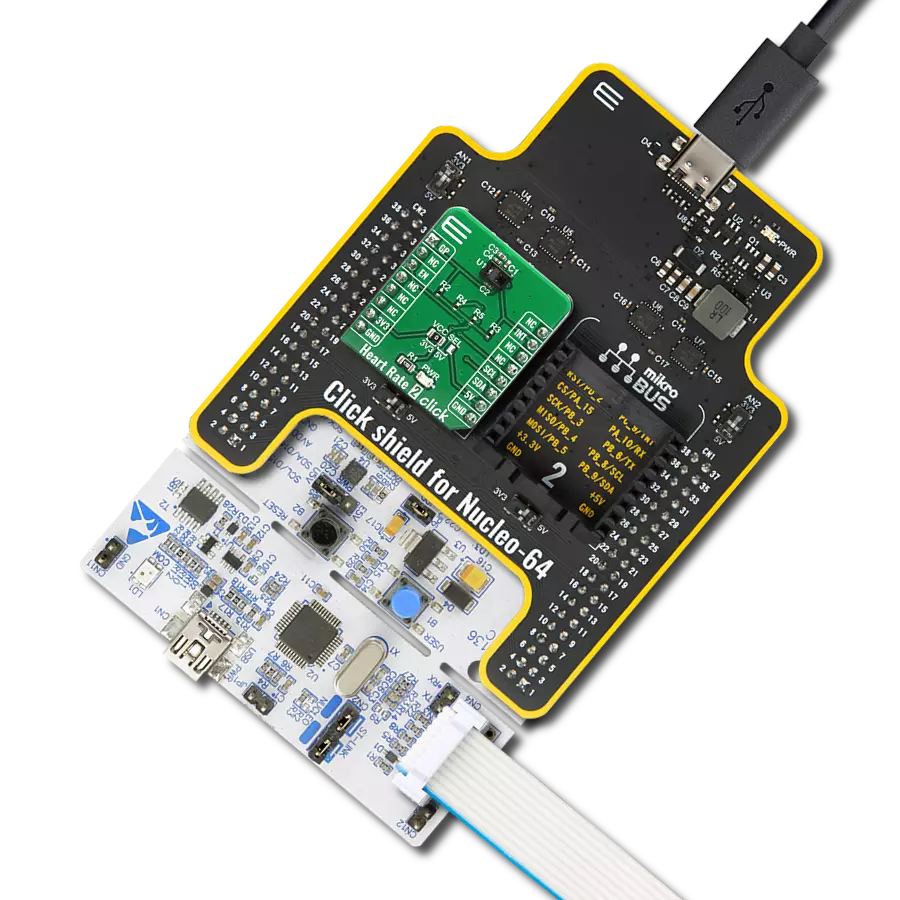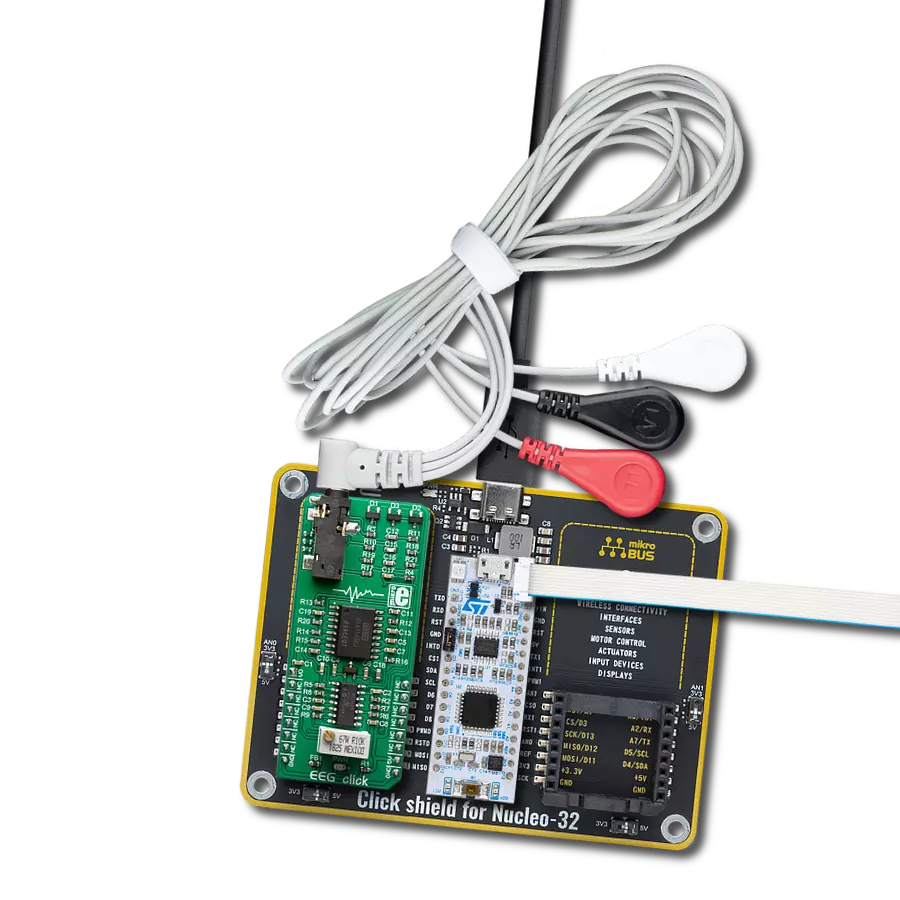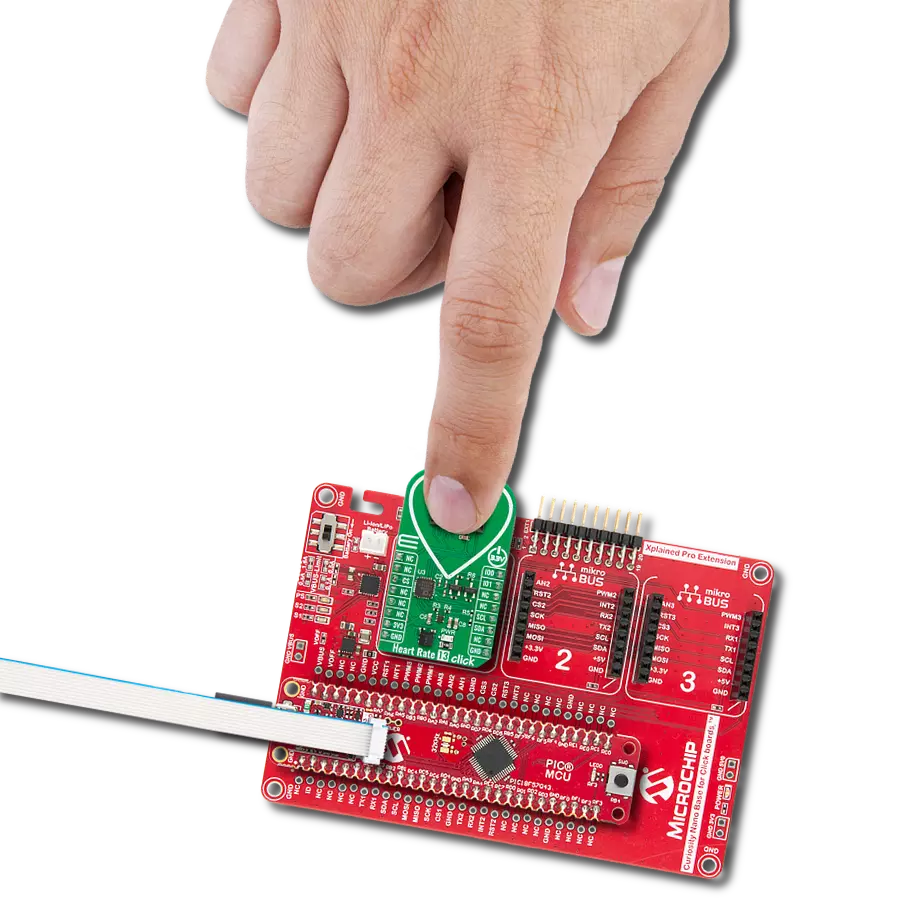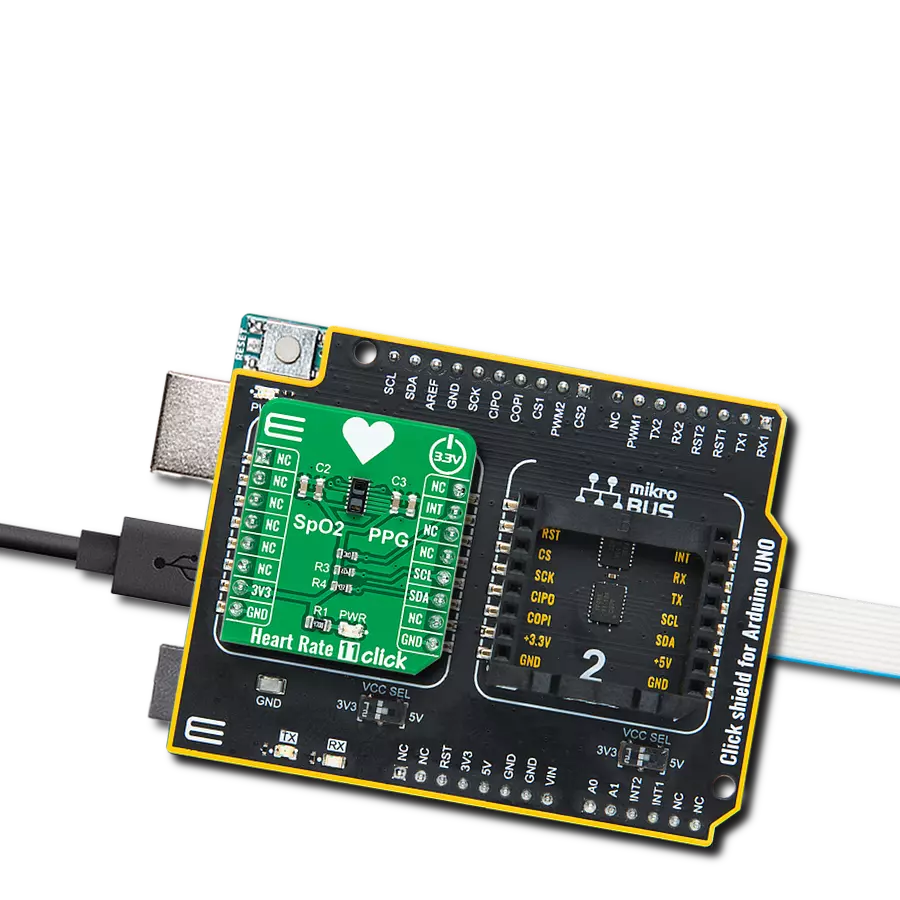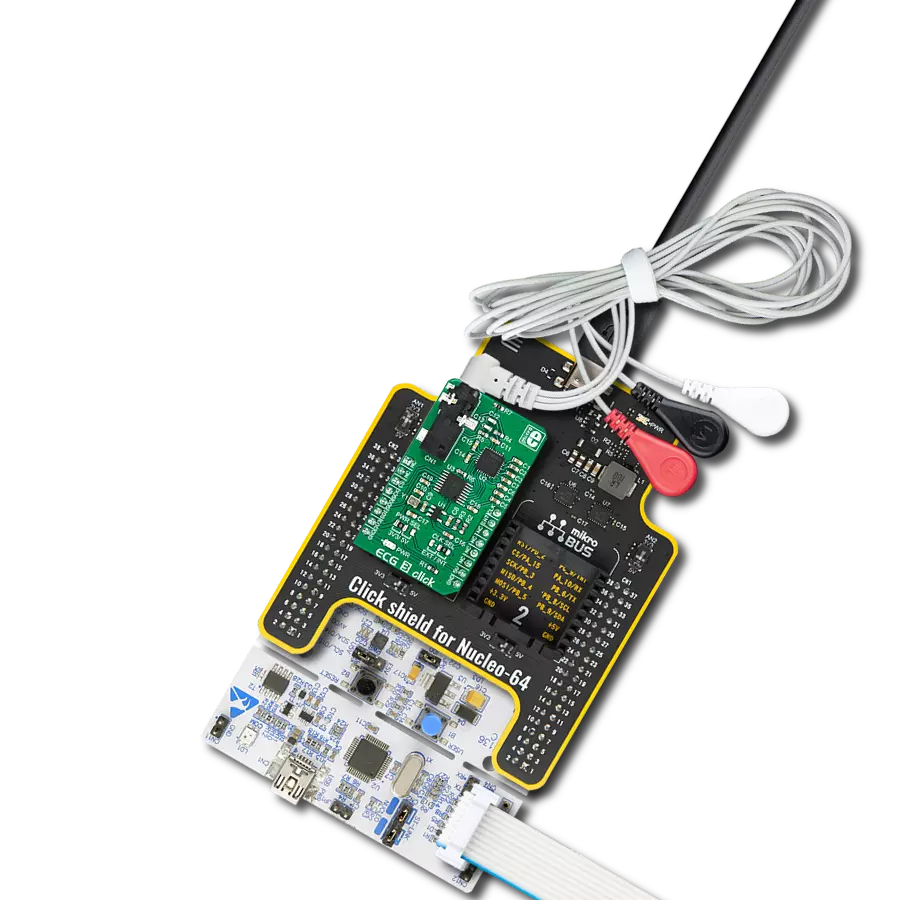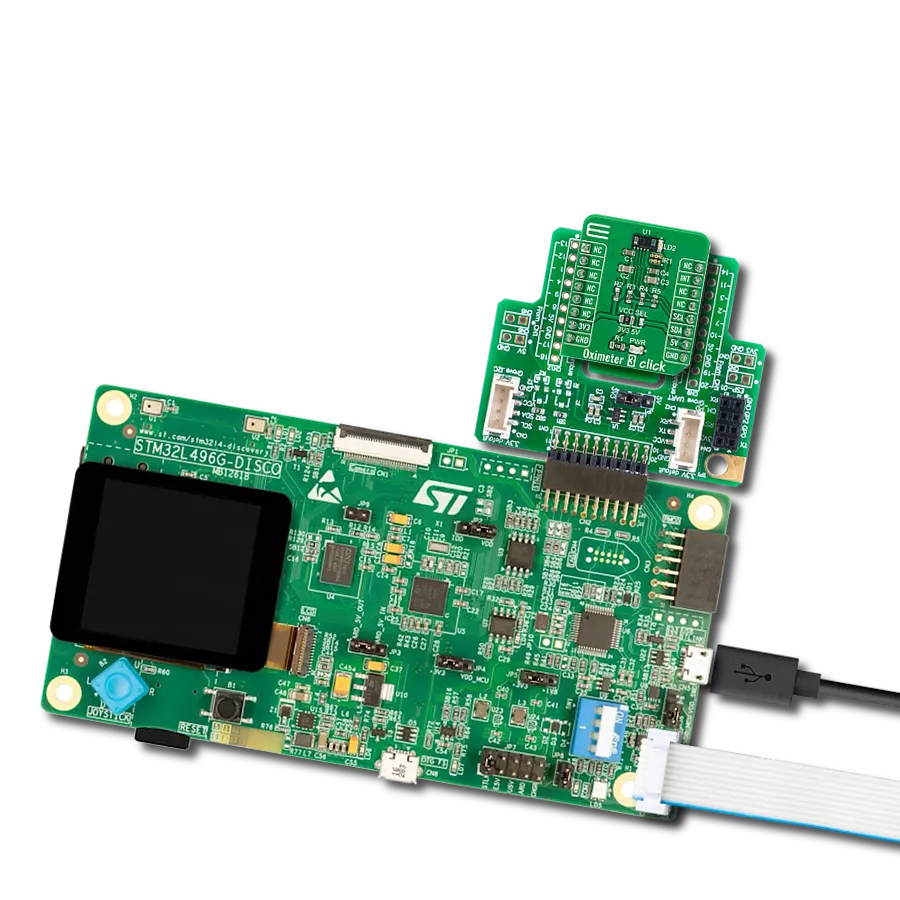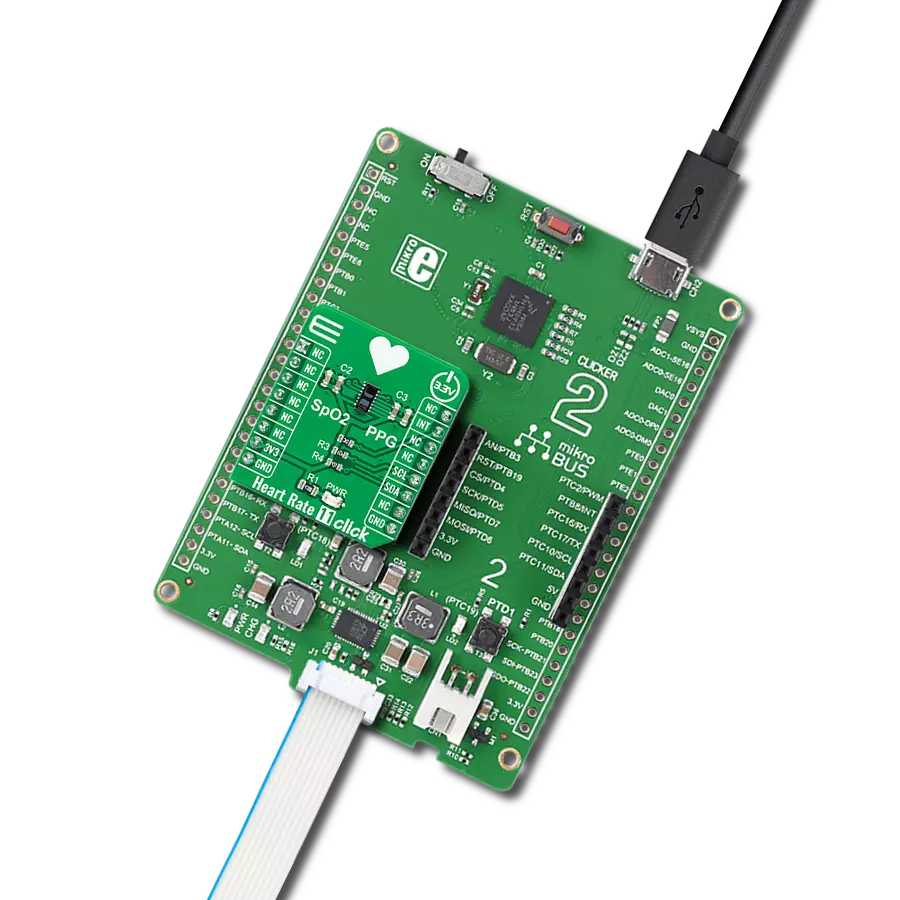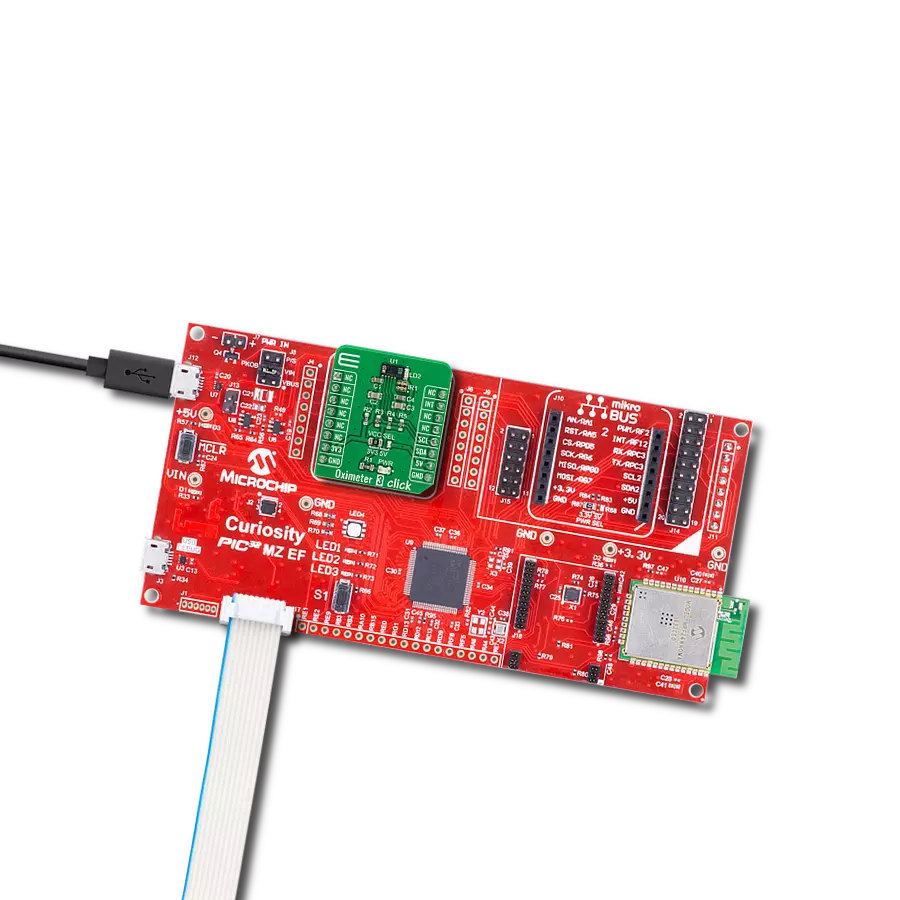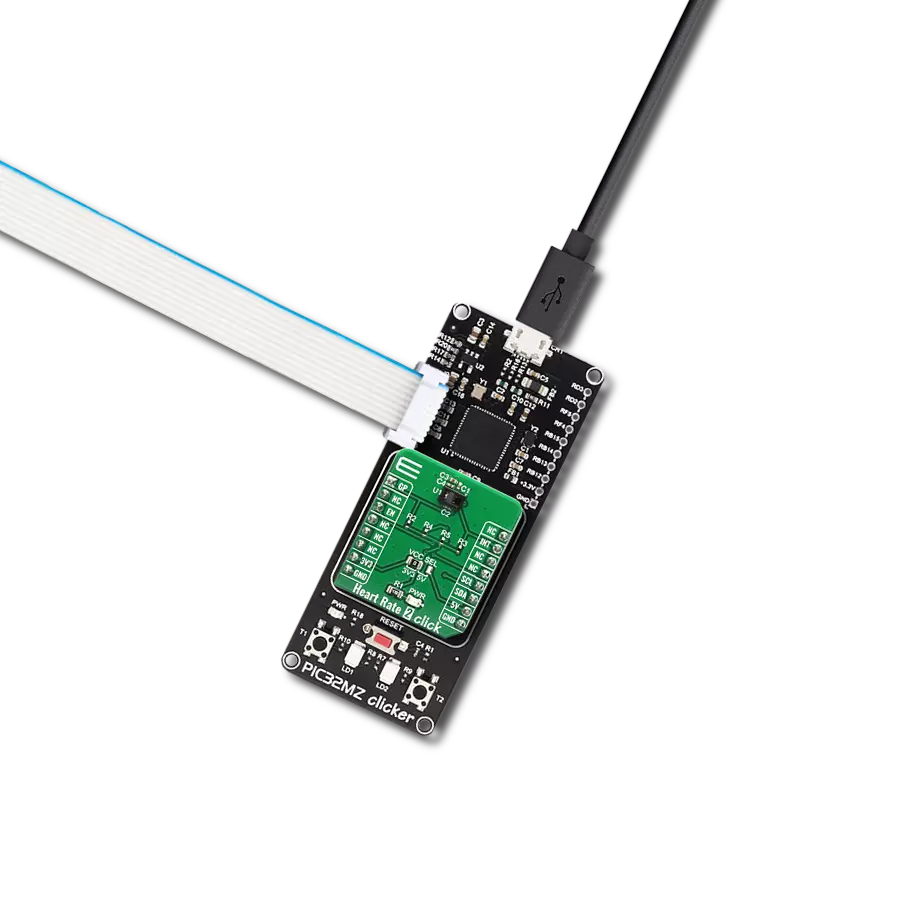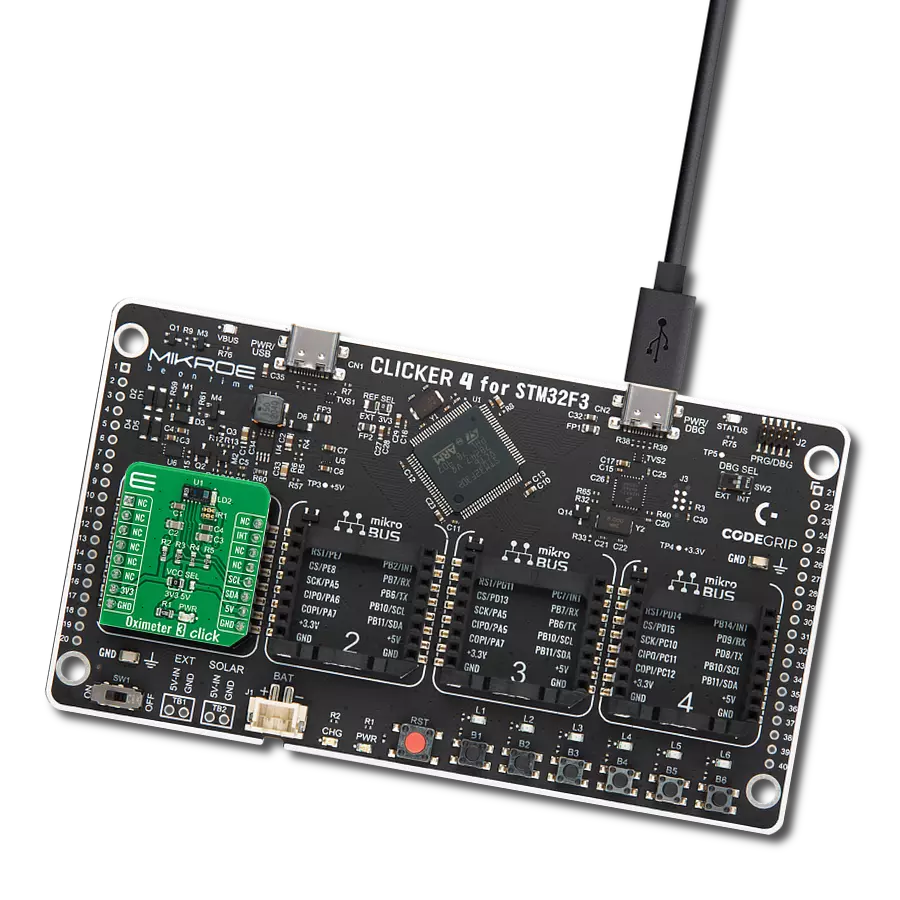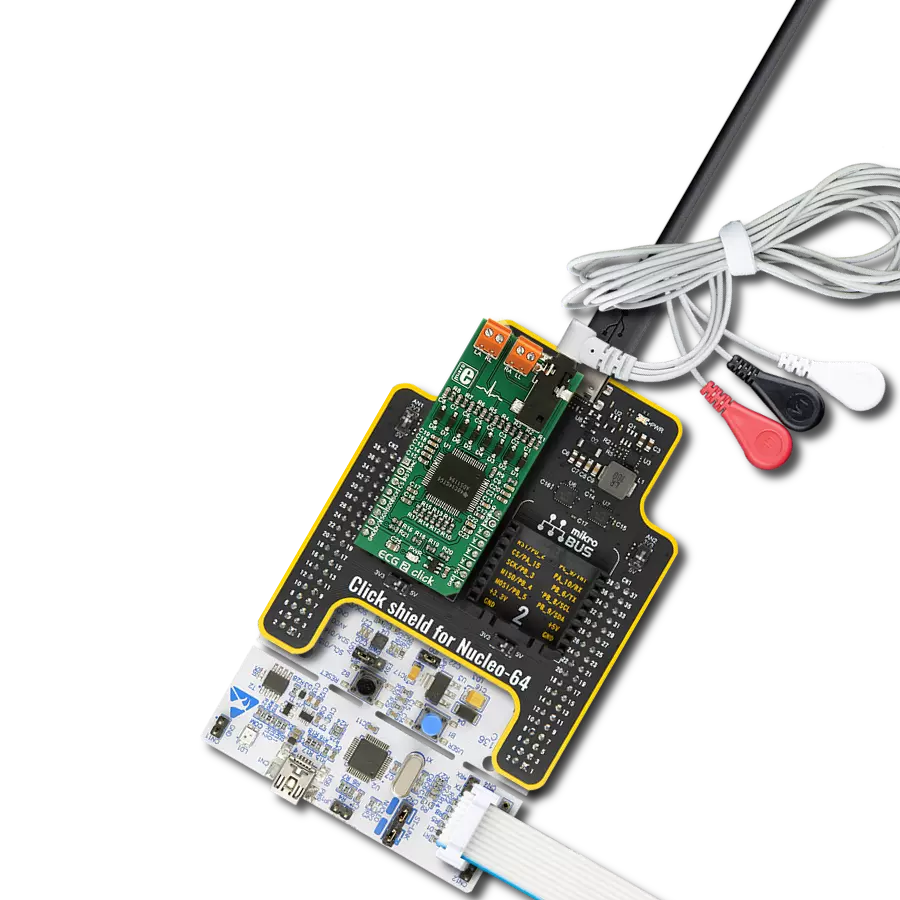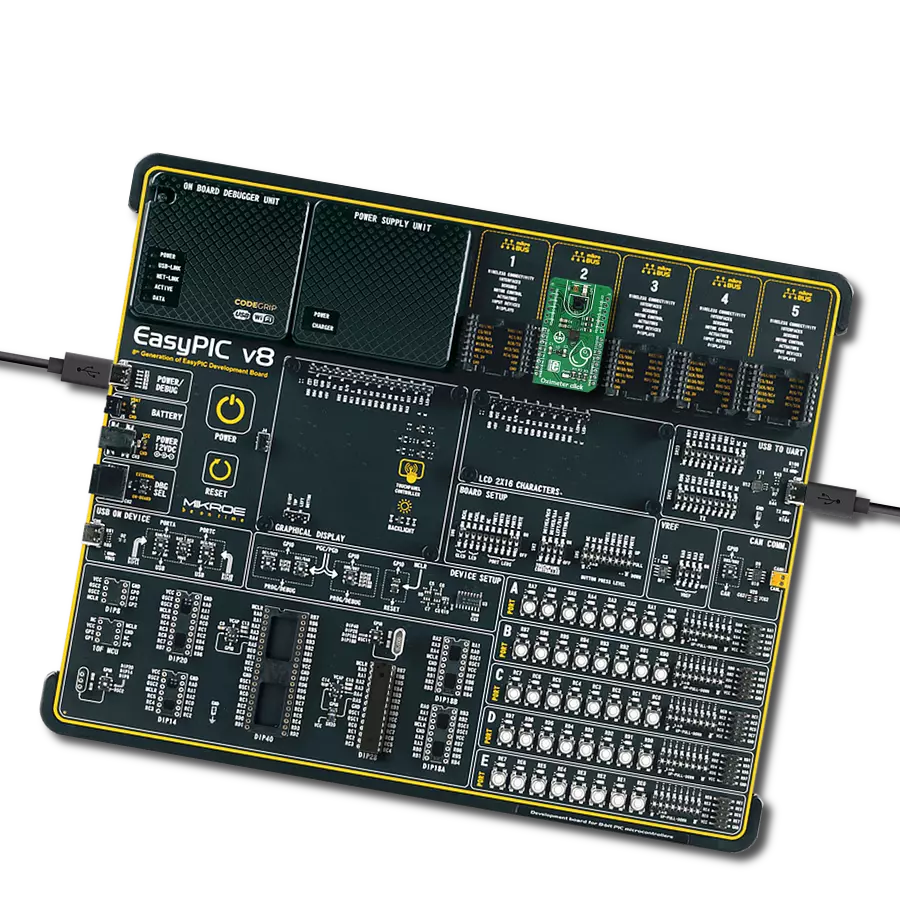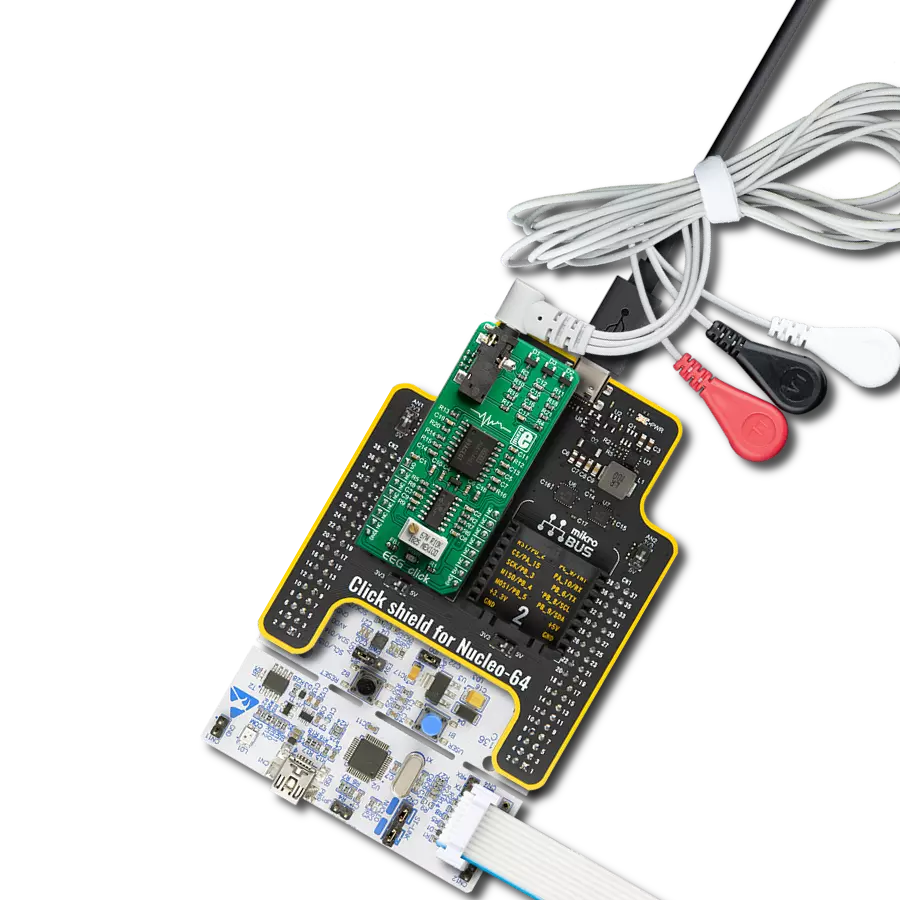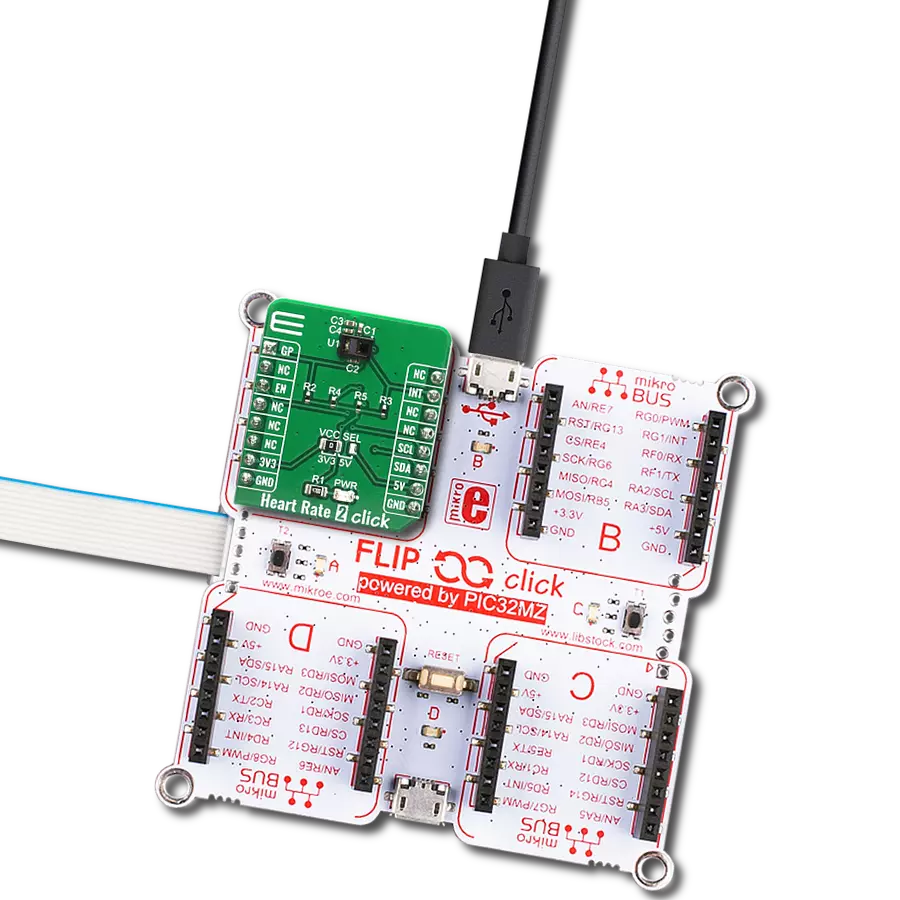Reach new heights with personalized heart rate monitoring
A
A
Hardware Overview
How does it work?
Heart rate 8 Click is based on the BH1792GLC, a monolithically integrated sensor for heart rate monitoring, from ROHM Semiconductor. This IC is a highly integrated optical sensor well-suited for performing PPM measurements. Due to the large integration scale of this sensor, as well as its low power consumption, it is perfectly suited to be used on a wearable IoT device. However, being a Click board™, Heart rate 8 click allows easy evaluation and rapid application and firmware development. Two green LEDs are driven by the integrated LED driving section of the BH1790GLC sensor, with the programmable Synchronized Measurement mode, with a measuring frequency between 32Hz and 1024Hz. While in this mode, two green LEDs will operate at various frequencies between 32Hz and 1024Hz, depending on the MSR bits of the measurement mode register. This allows automatic LED burst rate adjustment for achieving optimal readings. In this mode, a programmed number of measurements will be performed, and the readings will be stored on the 35 samples' deep FIFO buffer. LED current can be programmed from 0 to 63 mA, providing another control layer while using this mode. Upon receiving the MEAS_SYNC command, the measurement is performed by setting the MEAS_SYNC bit to logic 1. There are also two additional modes: Non-Synchronized, and Single Measurement mode, both allowing the IR LED to
detect an IR-emitting object, such as the hand or finger. The current through the LEDs can also be programmed from 0 to 63mA for both the IR and the green LEDs. Non-Synchronized mode offers a fixed 4 Hz LED burst operation, while the Single Measurement mode allows manual control of all the parameters. No data will be stored on the FIFO buffer in this mode. Upon receiving the MEAS_ST command, the measurement is performed by setting the MEAS_ST bit to logic 1. The reflected light burst is detected by a sensing element as a photo-diode, sampled by a low-noise 16-bit A/D converter. The photo-diodes are located behind two light filters which pass only a narrow band of green light in the range from 520nm to 560nm, with a 0.8X reduction in the center frequency. The top filter is an IRCUT filter that prevents the influence of the IR light, while the second filtering layer only passes the green light. This allows an even broader color range of LEDs to be used, reducing the overall cost of the design. However, Heart rate 8 click uses a pair of specialized green LEDs with a spectral response closely matched to the passband properties of the optical filter. This allows most of the LED energy to be used, further improving the power consumption profile. The second A/D converter does not filter light, allowing the light from the IR diode to be sensed. This is useful when a separate detection of the IR spectrum is required, for example, to detect an
approach of the finger. The IR LED driver is physically shared with the second green LED driver, but the IR LED has its dedicated pin. Two sets of four output registers contain the 16-bit measurement data in the form of two 8-bit words for the measurement when the LEDs are ON and when the LEDs are OFF. The upper and the lower 8-bit registers contain the measurement data, which can be retrieved over the standard I2C interface. The datasheet of the BH1792GLC contains the correct algorithms, which describe the measurement process in more detail. However, the Click board™ comes with the library, which contains functions that allow measurements to be performed with minimum effort. A dedicated programmable INT pin can signal an interrupt to the host MCU. The interrupt can be triggered for several events, including the data ready event (measurement completed), an event when the IR threshold is exceeded, and a so-called watermark event when the FIFO buffer is nearly full. It can also be completely disabled. The INT pin is routed to the INT pin of the mikroBUS™. A low number of external components required by the BH1792GLC sensor allows enough room on the Click board™ for the PCA9306 IC, a well-known I2C level translator, allowing the Heart rate 8 click to be interfaced with many different MCUs, both operating with 3.3V and 5V logic levels.
Features overview
Development board
Nucleo-64 with STM32L073RZ MCU offers a cost-effective and adaptable platform for developers to explore new ideas and prototype their designs. This board harnesses the versatility of the STM32 microcontroller, enabling users to select the optimal balance of performance and power consumption for their projects. It accommodates the STM32 microcontroller in the LQFP64 package and includes essential components such as a user LED, which doubles as an ARDUINO® signal, alongside user and reset push-buttons, and a 32.768kHz crystal oscillator for precise timing operations. Designed with expansion and flexibility in mind, the Nucleo-64 board features an ARDUINO® Uno V3 expansion connector and ST morpho extension pin
headers, granting complete access to the STM32's I/Os for comprehensive project integration. Power supply options are adaptable, supporting ST-LINK USB VBUS or external power sources, ensuring adaptability in various development environments. The board also has an on-board ST-LINK debugger/programmer with USB re-enumeration capability, simplifying the programming and debugging process. Moreover, the board is designed to simplify advanced development with its external SMPS for efficient Vcore logic supply, support for USB Device full speed or USB SNK/UFP full speed, and built-in cryptographic features, enhancing both the power efficiency and security of projects. Additional connectivity is
provided through dedicated connectors for external SMPS experimentation, a USB connector for the ST-LINK, and a MIPI® debug connector, expanding the possibilities for hardware interfacing and experimentation. Developers will find extensive support through comprehensive free software libraries and examples, courtesy of the STM32Cube MCU Package. This, combined with compatibility with a wide array of Integrated Development Environments (IDEs), including IAR Embedded Workbench®, MDK-ARM, and STM32CubeIDE, ensures a smooth and efficient development experience, allowing users to fully leverage the capabilities of the Nucleo-64 board in their projects.
Microcontroller Overview
MCU Card / MCU
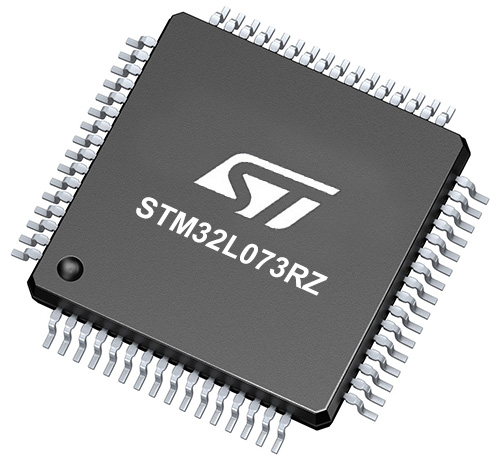
Architecture
ARM Cortex-M0
MCU Memory (KB)
192
Silicon Vendor
STMicroelectronics
Pin count
64
RAM (Bytes)
20480
You complete me!
Accessories
Click Shield for Nucleo-64 comes equipped with two proprietary mikroBUS™ sockets, allowing all the Click board™ devices to be interfaced with the STM32 Nucleo-64 board with no effort. This way, Mikroe allows its users to add any functionality from our ever-growing range of Click boards™, such as WiFi, GSM, GPS, Bluetooth, ZigBee, environmental sensors, LEDs, speech recognition, motor control, movement sensors, and many more. More than 1537 Click boards™, which can be stacked and integrated, are at your disposal. The STM32 Nucleo-64 boards are based on the microcontrollers in 64-pin packages, a 32-bit MCU with an ARM Cortex M4 processor operating at 84MHz, 512Kb Flash, and 96KB SRAM, divided into two regions where the top section represents the ST-Link/V2 debugger and programmer while the bottom section of the board is an actual development board. These boards are controlled and powered conveniently through a USB connection to program and efficiently debug the Nucleo-64 board out of the box, with an additional USB cable connected to the USB mini port on the board. Most of the STM32 microcontroller pins are brought to the IO pins on the left and right edge of the board, which are then connected to two existing mikroBUS™ sockets. This Click Shield also has several switches that perform functions such as selecting the logic levels of analog signals on mikroBUS™ sockets and selecting logic voltage levels of the mikroBUS™ sockets themselves. Besides, the user is offered the possibility of using any Click board™ with the help of existing bidirectional level-shifting voltage translators, regardless of whether the Click board™ operates at a 3.3V or 5V logic voltage level. Once you connect the STM32 Nucleo-64 board with our Click Shield for Nucleo-64, you can access hundreds of Click boards™, working with 3.3V or 5V logic voltage levels.
Used MCU Pins
mikroBUS™ mapper
Take a closer look
Click board™ Schematic

Step by step
Project assembly
Software Support
Library Description
This library contains API for Heart rate 8 Click driver.
Key functions:
heartrate8_get_data- Function gets the selected data from the determined LED Data registersheartrate8_check_int- Function checks INT pin, is interrupt occured or notheartrate8_meas_sync- Function performs the measurement synchronization
Open Source
Code example
The complete application code and a ready-to-use project are available through the NECTO Studio Package Manager for direct installation in the NECTO Studio. The application code can also be found on the MIKROE GitHub account.
/*!
* \file
* \brief HeartRate8 Click example
*
* # Description
* This example demonstrates the use of Hearth rate 8 Click board.
*
* The demo application is composed of two sections :
*
* ## Application Init
* Performs the device reset, after which the device configuration can be performed. The device is configured to work in Single Measurement Mode with LED pulsing.
* The driver which is selected is driver for the GREEN LED Data.
*
* ## Application Task
* Sends command to start measurement cycle, then waits until measurement cycle is finished.
* When measurement cycle is done, gets LED ON and LED OFF Data for the selected LED driver (GREEN or IR LED) and performs data
* plotting on serial plotter every 35ms.
*
*
* \author MikroE Team
*
*/
// ------------------------------------------------------------------- INCLUDES
#include "board.h"
#include "log.h"
#include "heartrate8.h"
// ------------------------------------------------------------------ VARIABLES
static heartrate8_t heartrate8;
static log_t logger;
static uint8_t int_check;
static uint16_t led_data_on;
static uint16_t led_data_off;
static uint32_t i;
// ------------------------------------------------------- ADDITIONAL FUNCTIONS
void plot_res( uint16_t plot_data )
{
log_printf( &logger, "%u,%u\n", plot_data, ++i );
if ( i == 0xFFFFFFFF )
{
i = 0;
}
Delay_ms ( 35 );
}
void log_res( )
{
log_printf( &logger, "LED ON Data : %u ", led_data_on );
log_printf( &logger, "LED OFF Data : %u\n", led_data_off );
Delay_ms ( 100 );
}
// ------------------------------------------------------ APPLICATION FUNCTIONS
void application_init ( void )
{
log_cfg_t log_cfg;
heartrate8_cfg_t cfg;
/**
* Logger initialization.
* Default baud rate: 115200
* Default log level: LOG_LEVEL_DEBUG
* @note If USB_UART_RX and USB_UART_TX
* are defined as HAL_PIN_NC, you will
* need to define them manually for log to work.
* See @b LOG_MAP_USB_UART macro definition for detailed explanation.
*/
LOG_MAP_USB_UART( log_cfg );
log_init( &logger, &log_cfg );
log_info( &logger, "---- Application Init ----" );
// Click initialization.
heartrate8_cfg_setup( &cfg );
HEARTRATE8_MAP_MIKROBUS( cfg, MIKROBUS_1 );
heartrate8_init( &heartrate8, &cfg );
heartrate8_default_cfg( &heartrate8 );
i = 0;
}
void application_task ( void )
{
heartrate8_start_measure( &heartrate8 );
int_check = heartrate8_check_int( &heartrate8 );
while ( int_check != HEARTRATE8_INT_ACTIVE )
{
int_check = heartrate8_check_int( &heartrate8 );
}
heartrate8_get_data( &heartrate8, HEARTRATE8_GREEN_DATA_GET, &led_data_on, &led_data_off );
plot_res( led_data_on );
int_check = heartrate8_int_clear( &heartrate8 );
Delay_ms ( 5 );
}
int main ( void )
{
/* Do not remove this line or clock might not be set correctly. */
#ifdef PREINIT_SUPPORTED
preinit();
#endif
application_init( );
for ( ; ; )
{
application_task( );
}
return 0;
}
// ------------------------------------------------------------------------ END
Additional Support
Resources
Category:Biometrics




















